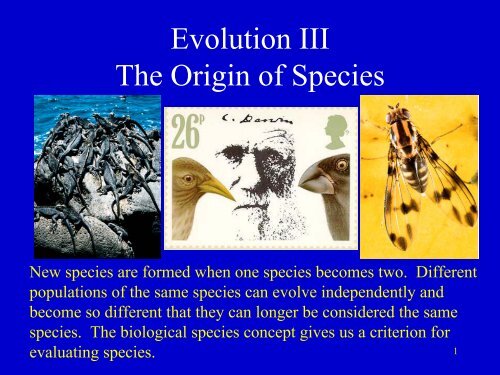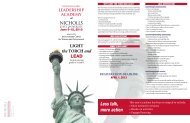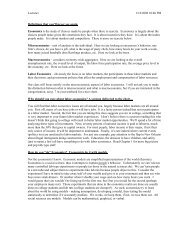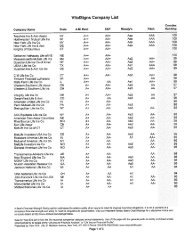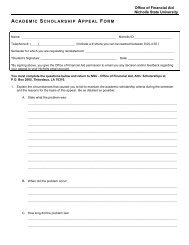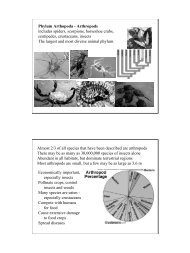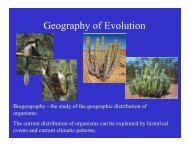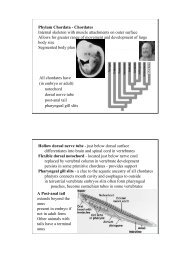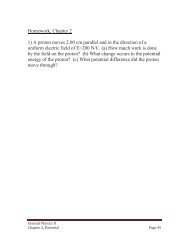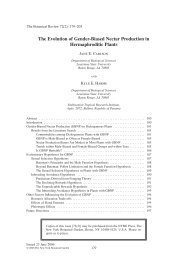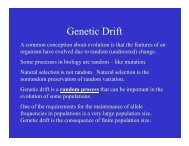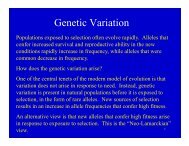Origin of Species
Origin of Species
Origin of Species
You also want an ePaper? Increase the reach of your titles
YUMPU automatically turns print PDFs into web optimized ePapers that Google loves.
Evolution IIIThe <strong>Origin</strong> <strong>of</strong> <strong>Species</strong>New species are formed when one species becomes two. Differentpopulations <strong>of</strong> the same species can evolve independently andbecome so different that they can longer be considered the samespecies. The biological species concept gives us a criterion forevaluating species.1
Cladogenesis - the origin <strong>of</strong> new genetic lineages - the formation<strong>of</strong> new species - speciationWhat is a species?Whether two organisms are the same species or not, for mostspecies, is not a difficult decision - house cats vs. dogs, groupersvs. tarpon, oaks vs pines. The difference between species reflectsmany generations <strong>of</strong> independent evolution and divergence froma common ancestor.2
The question is sometimes more difficult - when closely relatedforms are compared. The similarity is due to each only divergingslightly from their common ancestor.These snakes areall thought to bethe same species,having differentcoloration, andliving in differentareas <strong>of</strong> thecountry. They areclassified assubspecies <strong>of</strong> thesame species.3
Difference in body form, coloration, etc., <strong>of</strong>ten characterizesdifferent species but many times a single species can be highlyvariable.Humans haveproduced divergentforms from a singleancestor throughgenerations <strong>of</strong>artificial selectionthat are so differentthat they might bethought to bedifferent species ifthey were found innature.4
The biological species concept - a species is a population or agroup <strong>of</strong> populations that are reproductive isolated from all otherpopulations.Reproductive isolation - the inability to exchange geneticinformation. Two types <strong>of</strong> organism are reproductively isolatedif they lack the ability to mate and produce healthy fertile<strong>of</strong>fspring under natural conditions.Whether two organisms are reproductively isolated or not is <strong>of</strong>tendifficult to evaluate, most commonly because they live indifferent regions <strong>of</strong> the world. In such cases, their phenotypicsimilarity or differences, are commonly used as a criterion forplacing them in the same or different species.5
Reproductive isolation can be classified into two categories:Prezygotic Reproductive Isolation - the inability to exchangegenes, even when the two forms live in the same geographic area.Postzygotic Reproductive Isolation - the inability to producehealthy fertile <strong>of</strong>fspring, even though the two forms can mate andproduce a zygote.Within each category there are several modes or mechanisms <strong>of</strong>reproductive isolation.Prezygotic isolation includes ecological isolation, behavioralisolation, temporal isolation, mechanical isolation, and gameteincompatibilityPostzygotic isolation includes zygotic inviability and hybridsterility.6
Ecological isolation occurs whentwo species live in the same areabut do not encounter each otherbecause they exploit differentportions <strong>of</strong> the same habitat.Until recently lions and tigers hadoverlapping ranges in India. Theydid not mate, in part, becauselions live in open areas, and tigersprefer forests. They can, and willmate, and produce <strong>of</strong>fspring inzoos. In nature, they are goodbiological species.7
Behavioral isolation occurs when two species live in the samearea but do not recognize each other as mates because <strong>of</strong>behavioral differences.Many species <strong>of</strong> birds,reptiles, fish, andarthropods, haveelaborate courtship ritualswhere each potentialmate must exhibit theproper sequence <strong>of</strong>behaviors before matingcan occur.Lions and tigers exhibit behavioral isolation as well as ecologicalisolation. Lions are social animals, living in prides. Tigers aresolitary animals and associate as pairs only for mating.8
Temporal isolation occurs when two species, living in the samearea, don’t mate because <strong>of</strong> differences in their reproductivetiming. Locally, our white and brown shrimp spawn at differenttimes <strong>of</strong> the year. They lack the opportunity to mate.Mechanical isolation occurs when two species can’t matebecause their genitalia or some other aspect <strong>of</strong> their anatomy doesnot allow them to mate. Many insects have elaborate and speciesspecific genitalia - when mating they form a lock and key likerelationship. If the key doesn’t fit the lock, no mating is possible.Gamete incompatibility occurs when two species mate, but forvarious reasons, syngamy doesn’t occur. Sometimes the spermlack appropriate receptors for finding the egg. Sometimes thesperm lack the proper enzymes for digesting the jelly coatsurrounding the egg.9
Postzygotic Reproductive Isolation - the inability to producehealthy fertile <strong>of</strong>fspring, even though the two forms can mate andproduce a zygote.Hybrid or zygotic inviability is a common result <strong>of</strong> matingbetween two species. Fertilization occurs, but the zygote fails todevelop, or if it develops, the hybrid is not healthy and does notsurvive.10
Hybrid sterility isolates species. Thetwo species can mate and produce asterile but otherwise healthy <strong>of</strong>fspring.The sterility <strong>of</strong> the hybrid keeps thegene pools <strong>of</strong> the two species separate.When horses and donkeys are matedthey produce mules. Mules arecompletely sterile. The sterility resultsfrom problems in meiosis. Horseshave fewer chromosomes than donkeysand their genes are distributeddifferently among the chromosomes.In the mule, sterility is the result <strong>of</strong>inability to form viable eggs.Horses and donkeys are goodbiological species.11
How does reproductive isolation evolve?The most common mode <strong>of</strong> speciation is allopatric speciation.In allopatric speciation, one species becomes distributed into twoor more populations occupying different geographic areas andexchanging few or no individuals with other populations. Thepopulations become geographically isolated.In isolation, the two populations evolve independently. Theybecome different ecologically, behaviorally, develop reproductivetiming differences, or develop some other difference that wouldkeep them reproductively isolated if they were brought backtogether.Often the evolution <strong>of</strong> the allopatric populations is associatedwith adaptation to different environments. But, the evolution canalso involve chance changes in chromosome number, orarrangement, that results in postzygotic isolation.12
The geographic isolationmay involve twopopulations separated bygeological changes, orone or more smallpopulations colonizingisland habitats.Independent evolution inisolation results in theevolution <strong>of</strong> some type<strong>of</strong> difference that keepsthe two forms frommating when they comeinto contact again.Allopatric speciation is achance event.13
Speciation in cricket frogs (a hypothesis).Two very similar species <strong>of</strong> small frogs, are reproductivelyisolated in the areas where they overlap by a slight difference intheir calls. Females <strong>of</strong> one species don’t recognize males <strong>of</strong> theother.Before the last iceNorthern Southernage, a single species<strong>of</strong> cricket frog mayhave inhabitedmuch <strong>of</strong> southernN. America.During glacial melting, a 200 mile river separated two populations<strong>of</strong> the cricket frog in southeastern and southwestern N. America.After the retreat <strong>of</strong> the glaciers, the two populations came togetheragain in Louisiana and Mississippi. A call difference that evolvedduring separation, keeps the two species from exchanging genestoday.14
Speciation can also occur within the range <strong>of</strong> a single species, butthis probably only happens rarely.Sympatric speciation can occur through disruptive selection.First, a single species evolves two varieties each adapted todifferent portions <strong>of</strong> the same habitat. The two varieties can matebut mating between them produces poorly adapted <strong>of</strong>fspringbecause there is no intermediate habitat. If there are anytendencies in the two varieties that cause them choose onlymembers <strong>of</strong> the same variety for mating, those tendencies will befavored. Those who are not choosy will sometimes mate with theother variety and produce <strong>of</strong>fspring with low fitness. Thetendency to mate within a variety eventually becomes perfectedas a prezygotic isolating mechanism.Apple maggot flies may be a case <strong>of</strong> the beginning stages <strong>of</strong>sympatric speciation.15
Apple maggot flies may be a case <strong>of</strong> the beginning stages <strong>of</strong>sympatric speciation.The apple race emergesearly and parasitizes apples.The Haw race emerges lateand parasitizes haws. Anymating between a late appleApple race Haw racefly and an early haw fly willproduce hybrids with anintermediate emergence timewith few opportunities forparasitism.Those that avoid mating with the other race will produce <strong>of</strong>fspringwith emergence times appropriate for apples or haws.The two races already show some preferences in mating formembers <strong>of</strong> their own race.16
Anagenesis and cladogenesis combine to produce the diversity <strong>of</strong>life. Selection, mutation, genetic drift, etc. cause change within alineage. Isolated populations can become separate evolutionarylineages with their own novelties, and evolutionary future.17
Like a growingoak tree,producing moreand morebranches throughtime, so does thetree <strong>of</strong> life.The record <strong>of</strong>diversity found infossils shows thatlife has graduallyincreased indiversity throughtime.18
“Nothing in biology makes senseexcept in light <strong>of</strong> evolution.”Theodosius Dobzhansky 197319


